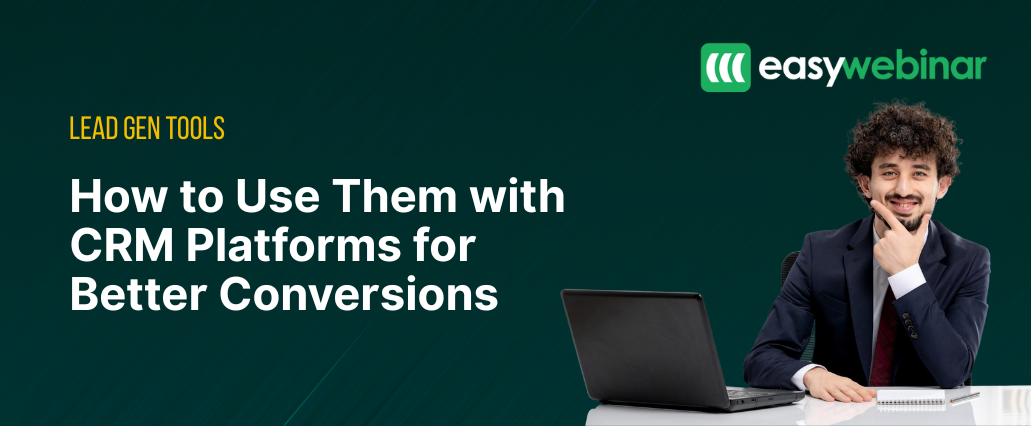Lead Gen Tools: How to Use Them with CRM Platforms for Better Conversions

Summary :
Integrating lead generation tools with CRM platforms transforms how businesses capture, track, and convert prospects. Automated workflows, lead scoring, and behavioral insights ensure timely follow-ups, personalized outreach, and improved conversions. EasyWebinar complements this ecosystem by capturing detailed attendee data, syncing it with your CRM, and triggering tailored follow-ups, creating a seamless, high-performing sales pipeline.
Table of Contents
- Understanding Lead Generation Tools and CRM
- Benefits of Integrating Lead Gen Tools with CRM
- How to Use Lead Gen Tools with CRM for Automation
- Optimizing Your Conversion Funnel with CRM Integration
- How EasyWebinar Enhances CRM-Based Lead Generation
- Conclusion
- FAQs
Lead generation CRM integration is vital for businesses that want to stimulate growth and maximize ROI. Your potential customers might choose competitors who actively reach out to them if you lack a solid lead generation strategy. A powerful combination of lead generation tools and your CRM platform creates a smooth system that captures leads and guides them through your sales pipeline.
Your business can automate repetitive tasks with a detailed lead generation platform while learning about prospect behavior. The game changes with lead generation automation that ranks leads based on their conversion potential. CRM automation schedules timely follow-ups so opportunities don’t slip away. The best lead generation CRM solutions help you personalize outreach efforts based on informed insights. These automated systems help you generate qualified leads consistently with minimal effort.
This piece examines the integration of lead generation tools with CRM platforms to streamline processes and enhance conversion rates.
Understanding Lead Generation Tools and CRM
You need effective strategies to capture and convert potential customers in today’s competitive marketplace. Understanding how lead generation tools work with CRM systems will make all the difference.
What are lead generation tools?
Lead generation tools are software platforms that attract potential customers into your sales funnel. These tools help nurture leads until they make a purchase. They collect your audience’s contact information through various touchpoints. This lets you communicate with them directly instead of losing them forever.
The best lead generation platforms come with these key features:
- Contact collection – Capturing email addresses or phone numbers via forms, landing pages, social media interactions, and pop-ups
- Personalization – Customizing interactions based on each prospect’s behavior and priorities
- Lead scoring – Identifying which prospects are ready to buy and which might be a good fit
- Automation – Collecting contacts 24/7 and triggering specific actions based on user behavior
- Analytics – Measuring the effectiveness of your lead generation efforts
Lead generation tools help you target users who already show interest in your products or services. They capture details, personalize interactions, and guide these leads to become customers. These platforms save time, remove human error, and give you the quickest way to generate leads.
What is CRM lead generation?
CRM lead generation covers the complete process of identifying, attracting, capturing, qualifying, and nurturing prospects toward conversion. CRM systems manage customer relationships throughout their lifecycle, unlike standalone lead generation tools that focus on the initial capture phase.
Your CRM system works as a central hub for all lead and customer data. It gathers interaction history with analytical insights and context. This complete view helps you understand who to target, what messages will appeal to them, and which leads need priority attention.
Research shows that businesses using CRM tools can improve sales by 29%. CRM integration can increase lead conversions by up to 300%. CRM software can boost customer retention by up to 27%. Even a 5% improvement in retention could increase profitability by 25-95%.
Why combining both matters
Lead generation tools and CRM systems create a powerful combination that guides the entire customer experience. Lead generation tools excel at capturing new prospects. CRM systems are great at managing relationships and nurturing those leads into customers.
This integration will give a seamless transfer of lead data. Information collected by your lead generation tools flows right into your CRM. This creates a single source of truth for all customer interactions. The system also enables sophisticated lead scoring and segmentation, so your team can focus on high-value prospects.
The combination improves response times and follow-ups. B2B marketers rank lead generation as their top goal, with 85% recognizing its role in business success.
Both sales and marketing teams can access lead data and insights through this integration. They can work together with a unified approach to customer communication – from initial capture through conversion and beyond.
Benefits of Integrating Lead Gen Tools with CRM
Your business can create a powerful system by connecting lead generation tools with your CRM platform. This combination optimizes your customer acquisition process. The system offers substantial advantages that standalone solutions cannot match.
Improved lead tracking and segmentation
A CRM working together with lead generation tools gives you a centralized hub for all customer and prospect data. Your team can see every interaction from the first website visit to the final purchase in one place. This detailed view helps your team track leads better throughout their experience.
The system lets you create sophisticated lead scoring systems. Your CRM rates leads automatically based on their engagement and behavior. This helps your team focus on prospects most likely to convert. Companies that use lead scoring have seen their conversion rates improve by up to 20%.
Integrated systems make segmentation much more effective. Your CRM can automatically:
- Group prospects by demographics, industry, or buying behavior
- Identify high-value segments for targeted campaigns
- Prevent missed opportunities with organized lead tracking
The CRM turns raw information into practical insights by capturing and organizing data at scale. Your team can spot trends in customer behavior and identify common obstacles in the buyer’s experience.
Faster response times and follow-ups
Quick responses matter in lead conversion. Sales reps who respond within five minutes are 100x more likely to connect with leads than those who wait an hour. Quick responders have an edge—up to 50% of B2B sales go to vendors who respond first.
Your CRM and lead generation tools working together create automated workflows that:
- Trigger personalized email sequences after form submissions
- Assign follow-up tasks to sales reps immediately
- Send timely reminders to keep leads warm
The CRM can distribute new inbound leads automatically among sales representatives to ensure quick attention to each prospect. Teams can focus on building relationships instead of handling administrative tasks because automation eliminates manual work that slows down responses.
The average lead response time is 47 hours, and teams only contact 27% of leads. Companies can gain an advantage over competitors using manual processes by implementing a CRM-powered response system.
Better personalization and targeting
Detailed insights from integrated systems help create highly personalized communications. Emails with personalized subject lines get 26% more opens. Marketers have seen a 760% increase in email revenue from segmented campaigns.
Your CRM gathers valuable data about each lead’s behavior, interests, and interactions. This helps create messages that appeal on an individual level. Teams can deliver content tailored to each prospect’s needs and stage in the buyer’s experience instead of using generic outreach.
The system becomes especially valuable when you have to trigger communications based on specific actions. The CRM can tag prospects automatically for targeted nurture sequences about related solutions when they download specific guides. This focused approach creates campaigns with a higher return on investment.
Sales and marketing teams can see lead behavior throughout the process. This visibility helps them adjust strategies based on immediate data. The CRM also helps determine the best times to contact prospects, which increases engagement rates substantially.

How to Use Lead Gen Tools with CRM for Automation
CRM integration with your lead generation process cuts down manual work and helps your team target high-converting prospects. A smooth connection between lead capture channels and your customer management system will build a quick sales pipeline that grows relationships at scale.
Setting up automated lead capture
Your lead generation automation starts by connecting all lead sources to your CRM. You need to find which channels bring the most valuable leads—website forms, landing pages, social media, or email campaigns. Next, create a direct data flow from these sources to your CRM.
To implement automated lead capture:
- Design conversion-focused forms and landing pages that feed directly into your CRM
- Set up triggers that instantly record lead information when submitted
- Create a centralized system that organizes leads from multiple sources
This setup records every interaction instantly and removes manual data entry. Your system works best when you use webhooks to connect multiple lead sources through a “catchall” system that formats and routes leads properly.
Using lead scoring to prioritize outreach
Lead scoring helps you rank prospects based on their conversion potential. A well-built system points your team toward the most promising opportunities.
To build effective lead scoring:
- Calculate your baseline lead-to-customer conversion rate
- Define ideal customer attributes based on demographics and behavior
- Assign point values to actions that associate with purchasing intent
- Compare attribute close rates against your baseline
Modern CRMs offer manual scoring with predetermined point systems and AI-powered predictive scoring that analyzes historical data to spot high-potential leads. These automated systems can track engagement metrics like email interactions, website visits, and content downloads to adjust lead priorities in real-time.
Triggering follow-up workflows based on behavior
CRM automation shines when you create responsive workflows triggered by specific lead behaviors. These systems handle timely follow-ups without constant manual oversight.
To automate based on behavior:
- Define trigger rules for important lead actions (page visits, content downloads)
- Configure action sequences (email sequences, task assignments, status updates)
- Set right timing parameters for each response
Research shows businesses that use behavior-triggered automation see a 77% increase in conversion rates. Smart workflows respond to engagement instead of static timers—when a lead visits your pricing page, they automatically get a relevant case study email two hours later.
This method personalizes each interaction automatically and keeps communication consistent throughout the buyer’s trip.
Optimizing Your Conversion Funnel with CRM Integration
CRM integration needs a strategic approach to optimize your sales funnel effectively. Your lead generation CRM helps you spot where prospects get stuck and lets you make targeted improvements to boost conversions.
Mapping the lead path inside your CRM
A complete view of your customer path within the CRM system reveals significant insights that often remain hidden. Lost deals happen at specific friction points along the customer’s path. A detailed lead path map helps you identify where and why potential clients stop engaging.
Your CRM system should collect all customer details, including profiles, contact history, and purchase data. The next step defines each stage of your sales funnel from awareness to loyalty. This setup enables your CRM to monitor how prospects move through these stages and records every interaction to show their complete experience.
The mapping turns assumptions into solid evidence. You can spot exactly where leads lose interest or stop moving forward. The process also helps you understand your prospects’ emotional state at each stage, which adds context to their decisions.
Using analytics to refine your funnel
Your CRM system gathers valuable information that forms the basis for ongoing funnel improvements. Evidence-based analytics help you spot stages with the most drop-offs so you can make focused improvements.
Tracking metrics between funnel stages reveals specific bottlenecks that need attention. This knowledge helps you use resources more efficiently by focusing on areas with the highest impact rather than spreading them thin.
CRM analytics show which campaigns perform best. Metrics like open rates, click-through rates, and conversion rates help you adjust your lead generation strategy with confidence.
Post-conversion data creates a powerful feedback loop when added to your analysis. This approach helps you optimize not just for initial conversions but also for each customer’s quality and lifetime value.
Arranging sales and marketing teams
Sales and marketing departments’ relationship directly affects company’s success. The CRM acts as a central hub where both teams can work together effectively.
Poor coordination between teams causes qualified leads to slip through your sales funnel. CRM integration solves this problem by ensuring both teams understand your target customer and key terminology in the same way.
To achieve coordination through your CRM:
- Set shared definitions and goals both teams understand
- Create joint metrics to measure success consistently
- Develop clear processes for lead handoffs
- Schedule regular cross-team reviews of funnel performance
Companies with coordinated sales and marketing teams see 27% faster profit growth and 36% higher customer retention rates. This teamwork ensures marketing campaigns appeal to prospects while sales approaches stay consistent, creating a smooth customer experience.

How EasyWebinar Enhances CRM-Based Lead Generation
Webinars excel as powerful tools in the lead generation ecosystem and work naturally with your CRM system. EasyWebinar turns standard webinar events into sophisticated lead generation machines that blend with your existing platforms.
Capturing leads through webinars automatically
Every registration form inside EasyWebinar is fully customizable. You can capture not just names and emails, but industry-specific details that qualify your leads better. Both live and automated webinars flow into the same system, ensuring your evergreen sessions keep capturing new leads long after your live event ends.
Syncing webinar data with your CRM
EasyWebinar’s direct integrations eliminate manual data entry by sending registrant and behavioral data straight into your CRM. Supported platforms include ActiveCampaign, GetResponse, Drip, Keap (Infusionsoft), Kit, AWeber, Mailchimp, HubSpot, Pardot, Ontraport, Constant Contact, and more. With these connections, you can apply action tags, launch automations, and trigger campaigns based on real-time attendee behavior—like attending live, clicking offers, or leaving early.
Using EasyWebinar to nurture leads post-event
With EasyWebinar’s Power Follow-Up, your audience is automatically segmented: those who registered but didn’t show up, those who dropped off midway, and those who stayed until the end. Each group can receive tailored follow-ups, like replay links, urgency-driven access restrictions, or special offers, driving higher engagement and faster conversions.
Conclusion
Combining lead generation tools with CRM platforms creates a powerful system that reshapes the scene of your sales process. This piece shows how this mutually beneficial alliance helps you capture, track, and guide leads while giving an explanation of prospect behavior.
Your connected systems build a smooth pipeline that works 24/7 to identify valuable prospects and move them toward conversion. The analytical insights help you pinpoint where prospects get stuck and make targeted improvements to your sales funnel.
Automation brings the biggest advantage to the table. Your integrated systems can score prospects, trigger tailored follow-ups and ensure quick responses—vital factors that boost conversion rates. Your team can focus on building relationships instead of managing spreadsheets or searching for contact information.
EasyWebinar blends into this ecosystem by capturing detailed attendee information and syncing it with your CRM. The behavioral data from webinar participants flows into your customer database, which enables targeted follow-up sequences based on specific actions. This level of customization improves your chances of converting prospects into customers by a lot.
The results speak for themselves—companies that line up their lead generation efforts with CRM capabilities see dramatic improvements in conversion rates, response times, and marketing ROI. Many organizations still operate these systems separately and miss valuable opportunities to optimize their processes.
Start today by evaluating how your current tools work together. Find integration points between your lead capture methods and CRM system, then set up automated workflows to cut down manual tasks. This all-encompassing approach will propel development and improve customer acquisition in today’s competitive marketplace.
FAQs
Q1. How can I integrate lead generation tools with my CRM system?
To integrate lead generation tools with your CRM, start by identifying your main lead sources and establish a direct data flow from these to your CRM. Set up automated lead capture by designing conversion-focused forms that feed directly into your CRM and create triggers to record lead information in real-time. Use webhooks to connect multiple lead sources and ensure all interactions are automatically recorded in your CRM.
Q2. What are the benefits of combining lead generation tools with CRM platforms?
Combining lead generation tools with CRM platforms offers several benefits, including improved lead tracking and segmentation, faster response times and follow-ups, and better personalization and targeting. This integration creates a centralized hub for all customer data, enables sophisticated lead scoring, automates workflows, and provides detailed insights for highly personalized communications.
Q3. How can I use CRM-based lead scoring to prioritize outreach?
To implement effective lead scoring, start by calculating your baseline lead-to-customer conversion rate and defining ideal customer attributes. Assign point values to actions that correlate with purchasing intent and compare attribute close rates against your baseline. Many modern CRMs offer both manual scoring systems and AI-powered predictive scoring that automatically analyzes historical data to identify high-potential leads.
Q4. What strategies can I use to optimize my conversion funnel with CRM integration?
To optimize your conversion funnel with CRM integration, start by mapping the entire lead journey inside your CRM to identify friction points. Use CRM analytics to refine your funnel by tracking metrics like conversion rates between stages and campaign performance. Additionally, use your CRM as a hub to align sales and marketing teams, establishing shared definitions, goals, and processes for lead handoffs.
Q5. How does EasyWebinar enhance CRM-based lead generation?
EasyWebinar enhances CRM-based lead generation by automatically capturing detailed attendee information through customizable registration forms. It syncs webinar data directly with popular CRM systems, eliminating manual data entry. The platform’s Power Follow-Up feature segments attendees based on their behavior, triggering personalized follow-up sequences